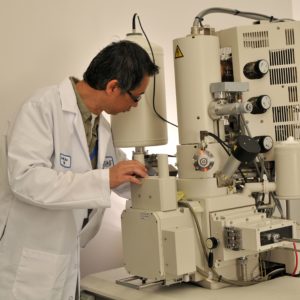Contaminant Identification
Home » Services » Materials Testing & Analysis » Contaminant Identification
Unexpected and unaddressed contamination can have a dramatic impact on manufacturing processes, therefore it is critical to understand and control it quickly. EAG scientists are experts at applying materials characterization techniques to search for and identify contaminants, determine their source and measure the effectiveness of contaminant removal/cleaning.
Choosing the appropriate technique or analytical approach depends upon the circumstances of the contamination event(s), the nature of the contaminant(s) and the goal of the analysis.
- Is the contaminant expected to be organic or inorganic?
- Is a large amount of contamination expected or only a little?
- Is the contamination expected to be widespread, localized, or particulate?
- Is it expected to be on the surface, in a specific layer, at an interface, or in the bulk of the material?
- Are trace levels important or does the presence of the contaminant only matter above a certain level?
- Is there a time or location dependent aspect regarding how the contaminant appears?
Approaches to Contaminant Identification
Often, a strategic, technical, multi-disciplinary approach is required to fully identify an unknown contaminant. The use of a comparison study between a control and suspect sample may also be helpful (or required). The specific technical approach is dependent on the sample matrix and the suspected level of contamination.
Once identification is complete, EAG scientists can further quantify the contaminant in the sample matrix by other methods or through quantification of existing data.
Related Resources
- App Note: Identification of Contamination Using FE-AES
- App Note: Imaging Cross Sections by TOF-SIMS
- App Note: Quantification of Pharmaceuticals by XPS
- App Note: Id of Foreign Material on Pharmaceutical Tablets
- App Note: Alkali Contamination in Thin Dielectric Films
- App Note: Identifying Contaminants Using Raman
- App Note: Organic Contamination on Surfaces
Types of Contaminant Identification
Typical contamination testing and identification projects have involved off-odor/flavor investigations, off-color problems, or foreign particles in a product. Some sources of contaminants have been from the environment, from improper storage of the product, or due to poor quality raw materials. We work closely with our clients to trace the source of contamination and develop a realistic corrective action program.
Listed below are many different types of contamination and potential techniques of interest to address them. The type of contamination can very much determine whether the technique used is successful. In some cases a combination of techniques may be needed, particularly if little is known about the contamination or if it is a mixture of components.
- Particles: SEM, EDS, Auger, FTIR, Raman, TOF-SIMS
- Residues: Auger, FTIR, XPS, TOF-SIMS
- Discoloration/stains: XPS, Auger, TOF-SIMS, FTIR
- Haze: SEM, AFM, OP, TOF-SIMS, XPS
- Layer: SEM-EDS, XPS, Auger, SIMS, TOF-SIMS
- Bulk: XPS, ICP-OES, ICP-MS, GDMS, XRF, FTIR
- Odor: GCMS
Would you like to learn more about Contaminant Identification?
Contact us today for your Contaminant Identification needs. Please complete the form below to have an EAG expert contact you.
